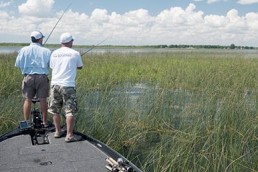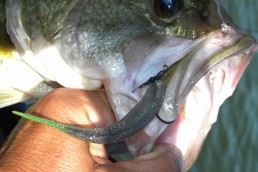Flash and Glitz bring out the Bite in Bass
SHARE THIS POST
Take a walk through a fishing tackle shop or through the sporting-goods section of a department store and look at all of the different fishing lures. They come in a wide variety of shapes, sizes and colors. It has been said that lures are being designed today to catch fishermen, not fish.
While that is undoubtedly true to some extent, there is one facet of many lures that makes them very attractive to fish. That one very important characteristic is flash. The flash of a lure when it is in the water mimics the flash of a baitfish as it turns to swim away. A whole school of baitfish makes a dizzying array of flashes as the pack of fish moves back and forth through the water.
The main baitfish (or forage fish) in many Indiana rivers and reservoirs is gizzard shad. The mighty Ohio River is home to huge numbers of shad. Lake Monroe, Patoka Lake and Brookville all host large shad populations. Gizzard shad are silver, and their movements produce a natural silver flash that attracts predators like largemouth bass from far and wide. When these bass are on the prowl, they are looking for distant flashes of silver to guide them towards the baitfish schools.
Since reservoir (and river) bass often key-in on the flash produced by baitfish, it makes sense that lures capable of reproducing that flash will be productive for the fishermen using them. Silver lures that produce a good flash usually top the list productive baits, but similar colors like gold and copper are just as good during periods of low light and low visibility underwater.
Flashy crankbaits
Crankbaits have been one of the most popular types of lures for catching largemouth bass for decades. Although they have been painted every color under the sun and even painted or molded to look exactly like many kinds of baitfish and panfish, some of the best crankbaits for bass are simply those with a lot of flash. Metallic silver and gold finishes make wooden or even plastic crankbaits as flashy as any natural shad.

Lipless crankbaits are one of the classic shad-imitating baits that use flash as a major attraction factor. Plain chrome baits with a black or blue back are hard to beat when schools of shad are around. The flat side of the bait really flashes when it is retrieved with an erratic stop-and-go action, and bass just love them. Many of these baits are also available with internal rattles. The rattling versions often out-produce the non-rattlers by a wide margin.
There are plenty of other excellent crankbaits that are made to look like shad, too. These are the diving crankbaits that have plastic or metal diving lips. Some of these are sinking models, some can suspend, but the vast majority are floaters. They all come in reflective silver and gold finishes (and plenty of other flashy color combinations), and they catch big bass in good numbers.
Good choices include Rat-L-Traps, LiveTarget Shad, Rapala Shad Raps, Reef Runner Ripshads and Little Rippers, Bagley Balsa Shad and Storm Wiggle Warts, just to name a few. There are scores of others to choose from, too.
Are you enjoying this post?
You can be among the first to get the latest info on where to go, what to use and how to use it!
One of the major advantages that diving crankbaits have over other lures like spoons is that the crankbaits are available in floating models. The beauty of a floater is that it can be retrieved extremely slowly without sinking to the bottom. The diving lip keeps it a foot or a few feet below the surface. If you reel too slowly, it simply heads back towards the surface. This is important during the cooler fall months when the water is getting colder and the fish are less active. Fast-moving baits can often be ignored.
Glitzy spoons
Just like crankbaits, spoons have been catching bass for years and years. One of the main reasons that they are so productive is that they imitate the flash of a baitfish almost perfectly. They wobble and tumble on the retrieve. Every time they turn, they reflect a flash of light. If the sky is clear and sunny, they reflect a bright flash. If it’s cloudy, the flash is more subdued—just like the flash from a baitfish on a cloudy day.
Spoons come in a wide variety of styles and sizes. There are wide-casting spoons that do a good job of imitating shad, and thinner spoons that look more like shiners or other slender minnows. Thick, narrow jigging spoons are another hot spoon type that takes plenty of bass out of deep water.
Although plain silver or gold spoons are great producers, different variations in color and finish can be even more deadly under certain circumstances. Hammered finishes scatter the reflected light differently than solid, polished finishes. Many fishermen believe they more accurately imitate the reflected scale pattern of the baitfish. Sometimes they’re the hot ticket, but not always. It pays to experiment!
Spoons with a splash of accent color are often much better than plain silver or gold, too. On certain days, a small stripe of blue, chartreuse or red seems to make all the difference. If bass are being finicky, try a spoon with a streak of color as an added attractant. Once the flash of the spoon calls the fish in close, the accent color often convinces reluctant fish to hit.
There are plenty of spoons to choose from, but a few of the more productive ones are Mepps Syclops, Al’s Goldfish, Acme Little Cleo, Eppinger Dardevle and Len Thompson spoons. There are lots of others, too.
Whether you prefer to cast spoons, crankbaits or both, be sure to keep the flash factor in mind when chasing bass out on your favorite lake or river. The fish will be keying-in on it, and you should, too!
MWO
SHARE THIS POST
Did you enjoy this post?
You can be among the first to get the latest info on where to go, what to use and how to use it!
Tom Berg
A lifelong outdoorsman and award-winning outdoor writer and nature photographer, Tom Berg has been the Executive Director/Treasurer of the Hoosier Outdoor Writers group for the past 14 years. When he is not writing, he would rather be outside fishing, hunting or trapping than doing just about anything else.



